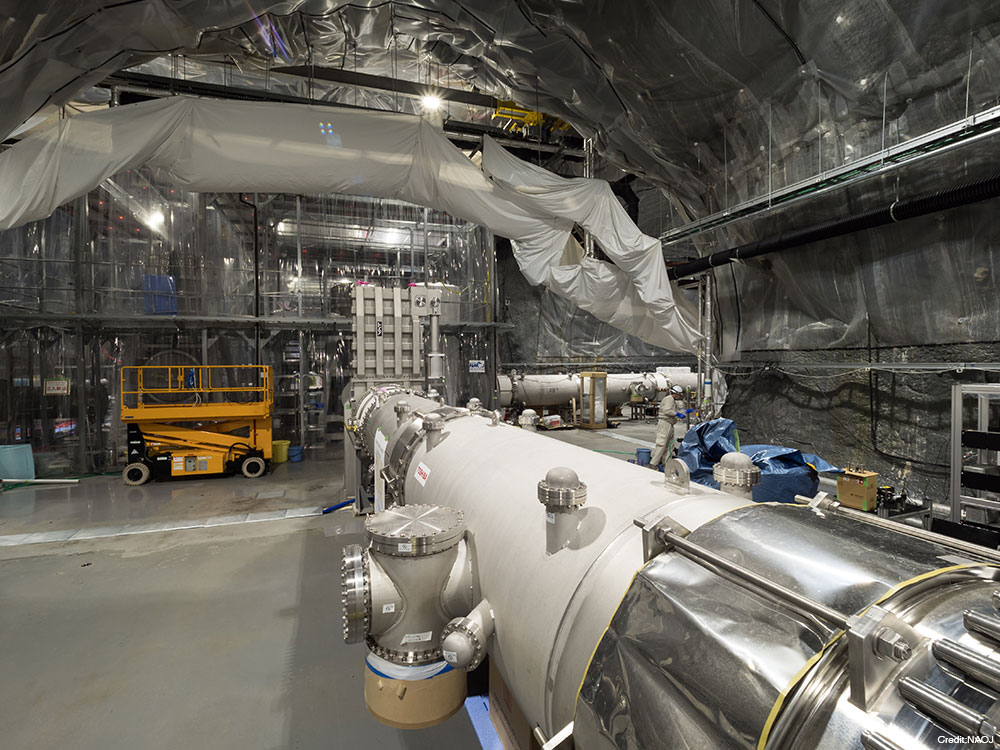What is the Large-scale Cryogenic Gravitational Wave Telescope KAGRA?
KAGRA is a large-scale cryogenic gravitational wave telescope constructed underground at the Kamioka Mine in Hida City, Gifu Prefecture, Japan. It features a 3-kilometer-long laser interferometer and is part of a global gravitational wave observation network alongside LIGO (USA) and Virgo (Europe). The telescope is undergoing repeated observation runs and upgrades to enhance global detection capabilities. Hosted by the Institute for Cosmic Ray Research (ICRR), University of Tokyo, with the National Astronomical Observatory of Japan (NAOJ) and the High Energy Accelerator Research Organization (KEK) as co-hosts, KAGRA involves collaboration with numerous universities and research institutions in Japan and abroad.

Research
Gravitational waves are ripples propagating through space-time. Unlike optical-infrared telescopes like the Subaru Telescope or radio telescopes like ALMA, which capture electromagnetic waves (oscillations in the electromagnetic field), KAGRA detects gravitational waves—distortions in space-time transmitted as waves. Its detection principle is fundamentally different from that of electromagnetic telescopes.
KAGRA uses a technique called laser interferometry. It detects the stretching and squeezing of space caused by gravitational waves by observing interference patterns between laser beams propagated along perpendicular paths. To increase sensitivity, KAGRA requires not only long baseline arms but also high-power laser sources, large-aperture and ultralow-loss mirrors, and ultrahigh-vacuum equipment. KAGRA incorporates a variety of cutting-edge technologies to achieve these goals. We are preparing to lead the upcoming era of gravitational wave astronomy.
The coalescence of binary neutron stars (BNS) is one of the key sources of gravitational waves. This astrophysical phenomenon can also be observed through electromagnetic signals such as gamma rays, optical light, infrared, and radio waves. KAGRA actively seeks collaboration with observatories beyond gravitational wave detectors, including the Subaru Telescope.
Specifications
| Location | Kamioka, Hida, Gifu, Japan |
|---|---|
| Detector | Laser interferometer (Michelson interferometer) |
| Baseline length | 3 kilometers |
| Main Features | - A 3-kilometer interferometer arm length - Stable underground site (200–450 m), optimal for reducing seismic noise - Mirror temperatures cooled to –250°C to suppress thermal noise - Sapphire mirrors, chosen for their superior performance at cryogenic temperatures |
History
| January 20, 2012 | Commencement Ceremony |
|---|---|
| May 2012 | Tunnel excavation begins |
| March 31, 2014 | Tunnel excavation completed |
| March 25, 2016 | Start of test operations |
| October 2019 | LIGO-Virgo-KAGRA (LVK) collaboration agreement concluded |
| April 2020 | International joint observation (O3GK) with Germany's GEO600 |
| May 2023 | Participation in international joint observation (O4a) with LIGO and Virgo |
| January 2024 | Operations affected by the Noto Peninsula earthquake disaster |
| June-October 2025 (planned) | Participation in international joint observation (O4c) with LIGO and Virgo |
